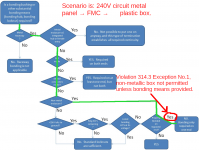300.4(G) Insulated Fittings. Where raceways contain 4 AWG or
larger insulated circuit conductors, and these conductors enter
a cabinet, a box, an enclosure, or a raceway, the conductors
shall be protected by an identified fitting providing a smoothly
rounded insulating surface, unless the conductors are separated
from the fitting or raceway by identified insulating material
that is securely fastened in place.
Exception: Where threaded hubs or bosses that are an integral part of a
cabinet, box, enclosure, or raceway provide a smoothly rounded or flared
entry for conductors.
Conduit bushings constructed wholly of insulating material
shall not be used to secure a fitting or raceway. The insulating
fitting or insulating material shall have a temperature rating
not less than the insulation temperature rating of the installed
conductors.


